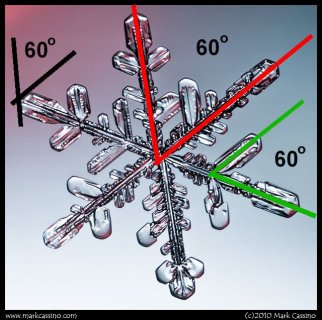| « Film frost grains and radiative cooling of the ground | That Snow Joke » |
Bad Snow
This post is about the misrepresenting of snow crystals in public, not about misbehaving crystals and not about snow that has gotten dirty.
No doubt you've seen it, the Christmas card with four-pointed "snow" falling, or the sweater with an eight-pointed "snow" emblem. Once, at a holiday party, I saw such a sweater and remarked on it to the wearer. I was told that, with snow, "no two are alike", and apparently that was supposed to justify anything goes. Sorry, but it doesn't work that way. After all, we can say the same thing about people, that is, no two of us are exactly alike, and yet we do not regularly see sketches of people with five arms or three heads. That is because people do not come in these shapes. Similarly, snow-crystal growth allows unlimited crystal forms, but nevertheless follows strict rules. If you understand these rules, you too can point out impossible snow-crystal shapes. I give the rules below.
But to help illustrate these rules, I first present below examples of real and "good" snow, together with some examples of bad snow:
Click on this (and any image here) to see a larger version.
What we call "ordinary" ice, of which snow is an example, has a hexagonal crystal structure. (Water-ice has other crystal structures, but so far only ordinary ice has been found to naturally occur on Earth.) This means that the crystal structure should look exactly the same when rotated about its primary axis by any multiple of 60 degrees. During crystal growth, the structure manifests itself in the existence of various crystal faces, and for snow, these faces include the prismatic faces, which differ in orientation by this same 60 degrees. So, if you can see prismatic faces on snow, they should all differ in orientation from each other by some multiple of 60 degrees. See how I marked this in black lines in the photo below:
Thus, Rule 1: Flat perimeters of snow (planar crystals) can differ in orientation only by multiples of 60 degrees.
Bad snow samples 4, 6, and 8 violate this rule.
Now, it turns out that, due to an interesting quirk of the way that snow grows (not explained in this post), that the above rule leads to the main branches differing in angle also by multiples of the same 60 degrees. This is the second rule, and is also illustrated in the image above -- note the angle between the red lines:
Rule 2: The angle between main branches should differ only by multiples of 60 degrees.
This rule also applies to the angle between a main branch and a side-branch, as shown by the angle between the green lines. This continues to the sub-side-branches: indeed, every branch-like protruberance in this crystal plane will differ by others by multiples of 60 degrees. And, allowing for all these sub-branches, this rule is violated by all of the bad examples except #4. Except for the tips of the branches and side-branches that break rule #1, #4 is actually a pretty good sketch.
The above two rules apply to all single crystals of snow. When the crystal form is a twin or poly-crystal, then they apply only to crystal regions on the same crystal, not between two crystals. Also, for the columnar crystal forms, rule 1 is violated because one generally views the perimeter of a basal face, not just the prismatic faces.
Example 3 has another feature that I think should not occur, though hesitate to call it impossible. It shows the outermost side-branches growing longer than the main branch. When the side-branches first sprout from a main branch, their tips sit in regions of lower vapor density, and thus should grow more slowly, at least initially. Thus, it is hard to see how they could overtake the main tips. If it ever happens, I'd like to see the example. And then I'd like to understand how it could happen.
The name "bad snow" of this post was inspired by the site "Bad Meteorology" (https://www.ems.psu.edu/~fraser/BadMeteorology.html). Now that you know about bad snow, I encourage you to check out this website and learn about "bad raindrops" and "bad greenhouse".
- JN

